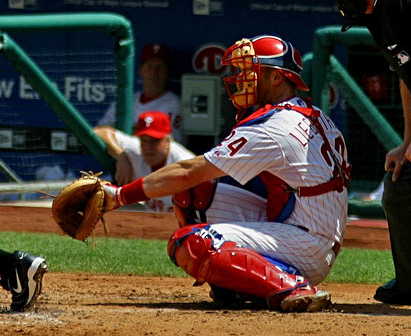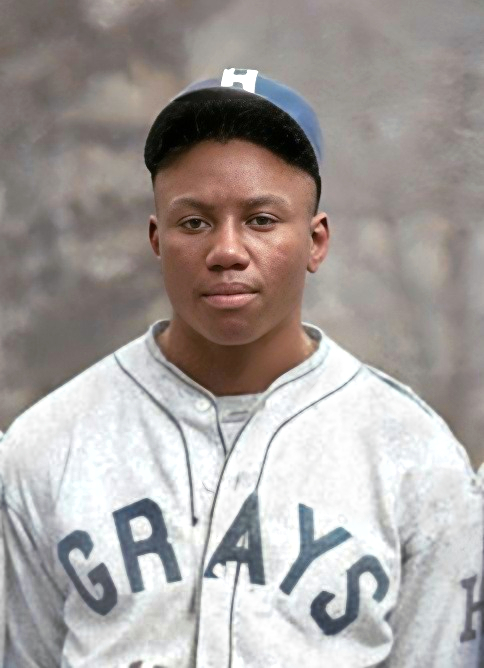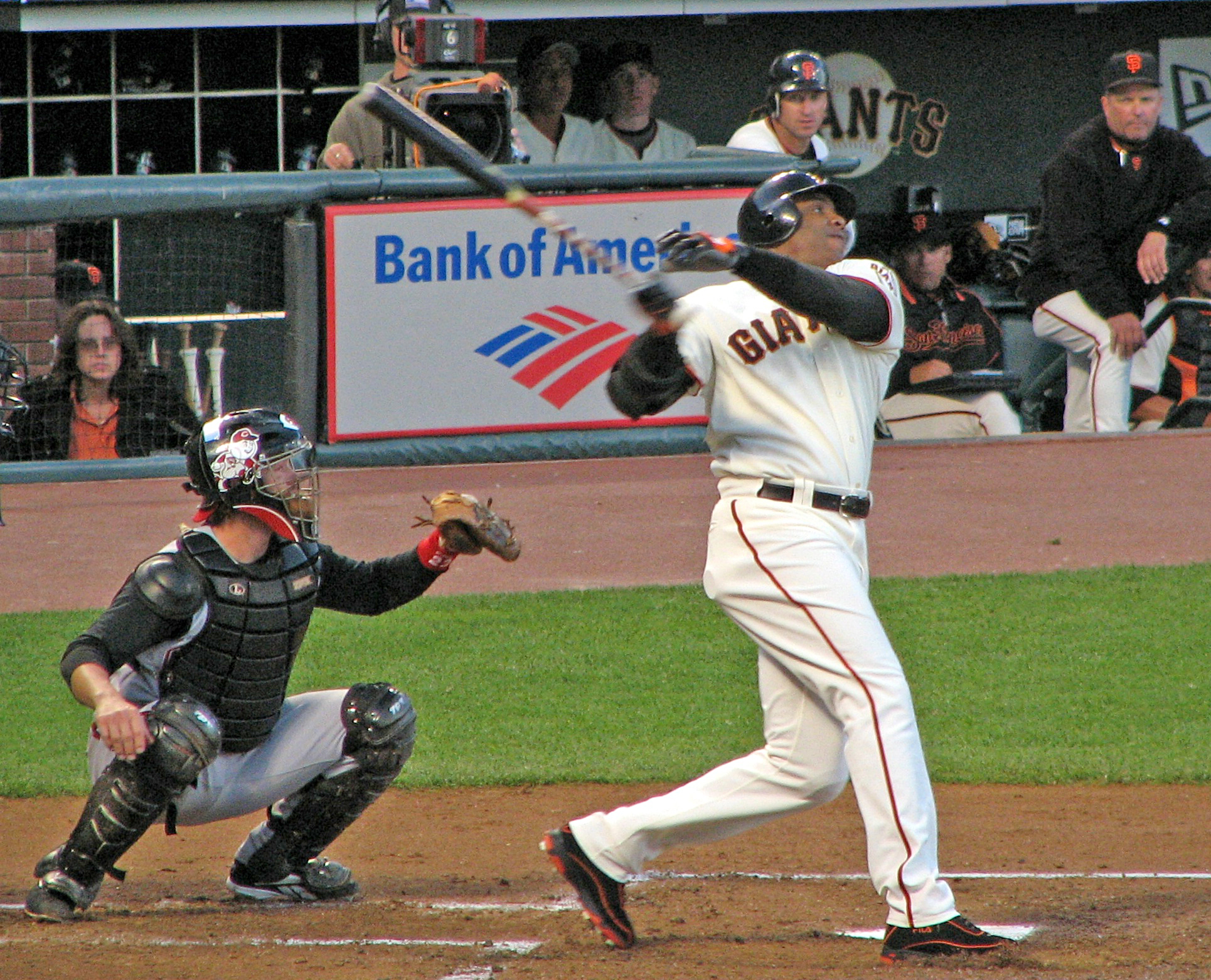|
Wes Parker
Maurice Wesley Parker III (born November 13, 1939) is an American former first baseman in Major League Baseball who played for the Los Angeles Dodgers from to . He also played one season in Japan for the Nankai Hawks in . As of 2009, Parker has been a member of the Los Angeles Dodgers organization serving as a representative of the Dodgers Legend Bureau. Biography Major League playing career Parker was part of the Dodgers' and World Series teams. Known as one of the slickest fielding first basemen of all time, he won the National League Gold Glove Award for first base every year from to 1972. In 1970, Parker posted a career high batting average of .319 and performed the unusual feat of driving in over 100 runs in a season while hitting no more than 10 home runs. In a game against the New York Mets on May 7, 1970, Parker hit for the cycle. He was the last Los Angeles Dodger to accomplish that feat until Orlando Hudson did so against the San Francisco Giants on April 13, ... [...More Info...] [...Related Items...] OR: [Wikipedia] [Google] [Baidu] |
First Baseman
A first baseman, abbreviated 1B, is the player on a baseball or softball team who fields the area nearest first base, the first of four bases a baserunner must touch in succession to score a run. The first baseman is responsible for the majority of plays made at that base. In the numbering system used to record defensive plays, the first baseman is assigned the number 3. Also called first sacker or cornerman, the first baseman is ideally a tall player who throws left-handed and possesses good flexibility and quick reflexes. Flexibility is needed because the first baseman receives throws from the other infielders, the catcher and the pitcher after they have fielded ground balls. In order for the runner to be called out, the first baseman must be able to ''stretch'' towards the throw and catch it before the runner reaches first base. First base is often referred to as "the other hot corner"—the "hot corner" being third baseman, third base—and therefore, like the third baseman ... [...More Info...] [...Related Items...] OR: [Wikipedia] [Google] [Baidu] |
San Francisco Giants
The San Francisco Giants are an American professional baseball team based in San Francisco. The Giants compete in Major League Baseball (MLB) as a member club of the National League (baseball), National League (NL) National League West, West Division. Founded in 1883 as the New York Gothams, the team was renamed the New York Giants (baseball), New York Giants three years later, eventually relocation of professional sports teams, relocating from New York City to San Francisco in 1958. The Giants play their home games at Oracle Park in San Francisco. The franchise is one of the oldest and most successful in professional baseball, with more wins than any other team in the history of Major professional sports leagues in the United States and Canada, major American sports. The team was the first major-league organization based in New York City, most memorably playing home games at several iterations of the Polo Grounds. The Giants have played in the World Series 20 times. In 2014, the ... [...More Info...] [...Related Items...] OR: [Wikipedia] [Google] [Baidu] |
1972 Major League Baseball Season
The 1972 major league baseball season was originally scheduled to begin on April 5. The 1972 strike caused the season to see its first 10 days of games canceled, resulting in the season starting on April 15, while the regular season ended as originally scheduled on October 4. The postseason began on October 7. The 69th World Series began with Game 1 with the Oakland Athletics of the American League defeating the Cincinnati Reds of the National League, four games to three, capturing their sixth championship in franchise history (and first in Oakland), since their previous in Philadelphia in . This was the first of three straight victories behind the bats of Reggie Jackson and Bert Campaneris, and the pitching cadre of Catfish Hunter, Rollie Fingers, and Vida Blue. Jackie Robinson, the player instrumental in breaking the AL and NL's color barrier, threw out the first pitch prior to Game 2 in what would be his last public appearance. He died two days after the series ended at age ... [...More Info...] [...Related Items...] OR: [Wikipedia] [Google] [Baidu] |
1972 Major League Baseball Strike
The 1972 Major League Baseball strike was the first players' Strike action, strike in Major League Baseball history. The strike occurred from April 1 to 13, 1972. Baseball resumed when the owners and players agreed on a $500,000 increase in pension fund payments. Owners agreed to add salary arbitration to the Collective Bargaining Agreement. The 86 total games that were missed over the 13-day period were not rescheduled, because the league refused to pay the players for the time they were on strike. As a result, the Houston Astros and San Diego Padres each played only 153 games, nine fewer than normal, and no team played more than 156 games. One major effect of the uneven schedule was that the 1972 Detroit Tigers season, Detroit Tigers played one more game than the 1972 Boston Red Sox season, Boston Red Sox, which enabled Detroit (with a record of 86–70) to win the American League East as Boston (with a record of 85–70) finished games behind, game behind. Detroit won the div ... [...More Info...] [...Related Items...] OR: [Wikipedia] [Google] [Baidu] |
Baseball-Reference
Baseball Reference is a baseball statistics database maintained by Sports Reference. The site provides career statistics for Major League Baseball (MLB) players and teams as well as records, MLB draft history, and sabermetrics. History Founder Sean Forman began developing the website while working on his Ph.D. dissertation in applied math and computational science at the University of Iowa. While writing his dissertation, he had also been writing articles on and blogging about sabermetrics. Forman's database was originally built from the '' Total Baseball'' series of baseball encyclopedias. The website went online in April 2000, after first being launched in February 2000 as part of the website for the ''Big Bad Baseball Annual''. It was originally built as a web interface to the Lahman Baseball Database, though it now employs a variety of data sources. In 2004, Forman founded Sports Reference. Sports Reference is a website that came out of the Baseball Reference website. ... [...More Info...] [...Related Items...] OR: [Wikipedia] [Google] [Baidu] |
Fielding Percentage
In baseball statistics, fielding percentage, also known as fielding average, is a measure that reflects the percentage of times a baseball positions, defensive player properly handles a batted or thrown ball. It is calculated by the sum of putouts and assist (baseball), assists, divided by the number of total chances (putouts + assists + error (baseball), errors). While a high fielding percentage is regarded as a sign of defensive skill, it is also possible for a player of lesser defensive skill to have a high fielding percentage, as it does not reflect or take into account a player's defensive range factor, range; a player who cannot get to a ball surrenders a hit (baseball), hit instead of having an opportunity to make an out (baseball), out or an error (baseball), error. Conversely, a highly skilled fielder might have a comparatively low fielding percentage by virtue of reaching, and potentially missing, a greater number of balls. In order to qualify for the league lead in fie ... [...More Info...] [...Related Items...] OR: [Wikipedia] [Google] [Baidu] |
Slugging Percentage
In baseball statistics, slugging percentage (SLG) is a measure of the batting productivity of a hitter. It is calculated as total bases divided by at-bats, through the following formula, where ''AB'' is the number of at-bats for a given player, and ''1B'', ''2B'', ''3B'', and ''HR'' are the number of singles, doubles, triples, and home runs, respectively: : \mathrm = \frac Unlike batting average, slugging percentage gives more weight to extra-base hits such as doubles and home runs, relative to singles. Such batters are usually referred to as sluggers. Plate appearances resulting in walks, hit-by-pitches, catcher's interference, and sacrifice bunts or flies are specifically excluded from this calculation, as such an appearance is not counted as an at-bat (these are not factored into batting average either). The name is a misnomer, as the statistic is not a percentage but an average of how many bases a player achieves per at bat. It is a scale of measure whose computed ... [...More Info...] [...Related Items...] OR: [Wikipedia] [Google] [Baidu] |
On-base Percentage
In baseball statistics, on-base percentage (OBP) measures how frequently a batting (baseball), batter reaches base (baseball), base. An official Major League Baseball (MLB) statistic since 1984, it is sometimes referred to as on-base average (OBA), as it is rarely presented as a true percentage. Generally defined as "how frequently a batter reaches base per plate appearance", OBP is specifically calculated as the ratio of a batter's times on base (the sum of Hit (baseball), hits, base on balls, bases on balls, and times hit by pitch) to the sum of at bats, bases on balls, hit by pitch, and sacrifice fly, sacrifice flies. OBP does not credit the batter for reaching base on error (baseball), fielding errors, fielder's choice, uncaught third strikes, Obstruction (baseball), fielder's obstruction, or catcher's interference, and deducts from plate appearances a batter intentionally giving himself up in a sacrifice bunt. OBP is added to slugging average (SLG) to determine on-base plus ... [...More Info...] [...Related Items...] OR: [Wikipedia] [Google] [Baidu] |
Base On Balls
A base on balls (BB), better known as a walk, occurs in baseball when a batter receives four pitches during a plate appearance that the umpire calls '' balls'', and is in turn awarded first base without the possibility of being called out. The base on balls is defined in Section 2.00 of baseball's Official Rules, and further detail is given in 6.08(a). Despite being known as a "walk", it is considered a faux pas for a professional player to actually walk to first base; the batter-runner and any advancing runners normally jog on such a play. The term "base on balls" distinguishes a walk from the other manners in which a batter can be awarded first base without liability to be put out (e.g., hit by pitch (HBP), catcher's interference). Though a base on balls, catcher's interference, or a batter hit by a pitched ball all result in the batter (and possibly runners on base) being awarded a base, the term "walk" usually refers only to a base on balls, and not the other methods of r ... [...More Info...] [...Related Items...] OR: [Wikipedia] [Google] [Baidu] |
Home Runs
In baseball, a home run (abbreviated HR) is scored when the ball is hit in such a way that the batter is able to circle the bases and reach home plate safely in one play without any errors being committed by the defensive team. A home run is usually achieved by hitting the ball over the outfield fence between the foul poles (or hitting either foul pole) without the ball touching the field. Inside-the-park home runs where the batter reaches home safely while the baseball is in play on the field are infrequent. In very rare cases, a fielder attempting to catch a ball in flight may misplay it and knock it over the outfield fence, resulting in a home run. An official scorer will credit the batter with a hit, a run scored, and a run batted in (RBI), as well as an RBI for each runner on base. The pitcher is recorded as having given up a hit and a run, with additional runs charged for each base-runner that scores. Home runs are among the most popular aspects of baseball ... [...More Info...] [...Related Items...] OR: [Wikipedia] [Google] [Baidu] |
Runs Scored
In baseball, a run is scored when a player advances around first, second and third base and returns safely to home plate, touching the bases in that order, before three outs are recorded and all obligations to reach base safely on batted balls are met or assured. A player may score by hitting a home run or by any combination of plays that puts him safely "on base" (that is, on first, second, or third) as a runner and subsequently brings him home. Once a player has scored a run, they may not attempt to score another run until their next turn to bat. The object of the game is for a team to score more runs than its opponent. The Official Baseball Rules hold that if the third out of an inning is a force out of a runner advancing to any base then, even if another baserunner crosses home plate before that force out is made, his run does not count. However, if the third out is not a force out, but a tag out, then if that other baserunner crosses home plate before that tag out i ... [...More Info...] [...Related Items...] OR: [Wikipedia] [Google] [Baidu] |
Batting Average (baseball)
In baseball, batting average (BA) is determined by dividing a player's hits by their total at-bats. It is usually rounded to three decimal places and read without the decimal: A player with a batting average of .300 is said to be "batting three hundred". If necessary to break ties, batting averages could be taken beyond the .001 measurement. In this context, .001 is considered a "point", such that a .235 batter is five points higher than a .230 batter. History Henry Chadwick, an English statistician raised on cricket, was an influential figure in the early history of baseball. He is credited with creating the modern box score, in 1859, and the practice of denoting a strikeout with a "K". Chadwick wrote in 1869: "In making up a score at the close of the match the record should be as follows:–Name of player, total number of times the first base was made by clean hits, total bases so made, left on bases after clean hits, and the number of times the first base has been made on ... [...More Info...] [...Related Items...] OR: [Wikipedia] [Google] [Baidu] |







